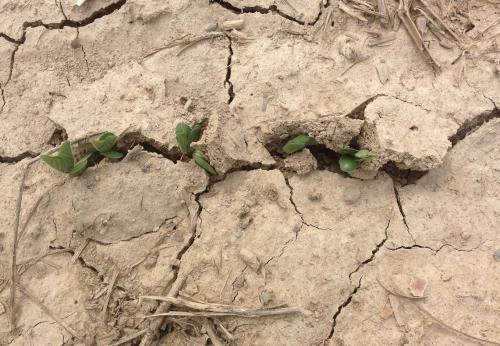Recommendations for planting large soybean seed
Large soybean seed may create some challenges. Understanding the challenges and the strategies for overcoming them will improve seed performance.

Soybean seed quality is very good this year. Mechanical damage to the seed coats or embryos is very low because the seed was harvested under good conditions. However, some of the seed is quite large at 2,100 to 2,400 seeds per pound. Genetics and the environmental conditions occurring during the growing season determine the size of the seed. Within a given variety, seed size can vary by as much as 20 percent. Abundant precipitation occurring during or after the R6 growth stage usually produces larger seed.
For a given variety, the size of the seed planted does not affect the yield potential as long as seed quality is high. However, the large seed may cause some management challenges for producers. Understanding these challenges and the strategies for overcoming them will improve seed performance.
The first step is to determine the size of the seed for each of your seed lots. The next step is to seek information from your operator’s manual, seed supplier and equipment dealer about equipping and setting your planter or drill to handle this year’s seed sizes. Taking these steps now will prevent problems such as reduced planting rates or damaged seed at planting.
Large seed (2,400 seeds per pound or less) can be damaged by the fluted metering system in drills. This type of damage can be reduced by plugging every other feed cup and opening up the seed metering gates. Some drills allow the feed cup to be lowered, increasing the space between the fluted seed metering mechanism and the bottom of the feed cup. Check your operator’s manual for specific recommendations.
Another potential concern with large seed is that the seed may have enlarged so quickly that it caused growth cracks in the seed coats. This is not a problem as the seed size was determined more by genetics than the environment.
Large seed produces larger cotyledons (seed leaves) than small seed. The larger cotyledons are more difficult to lift out of the soil during emergence. This may cause emergence problems in fine-textured soils prone to crusting. Planting the seed in wide rows and increasing the planting rate slightly is usually beneficial as the seeds are spaced closely enough within the row to crack the crust (see photos).

Planting slightly shallower and maintaining residue cover over the row will also help reduce emergence problems due to crusting. In some cases, a timely rotary hoeing may be required to break the crust. Please see the Michigan State University Extension article “Improving soybean emergence on soils prone to crusting." The loss of one cotyledon on a few plants during emergence will not affect yield. However, if a large percentage of plants lose one or both cotyledons, yields will be significantly reduced.
All soybean seed must imbibe 50 percent of its weight in water during germination. Large soybean seed must imbibe more water to germinate than small seed. This may lead to delayed or uneven emergence under marginal soil moisture conditions. Most agronomists recommend planting soybean seed into at least 0.5 inches of moist soil to promote uniform germination and emergence. This recommendation is even more important with large soybean seed.
This article was produced by a partnership between MSU Extension and the Michigan Soybean Committee.



 Print
Print Email
Email